Related Research Articles

A laser is a device that emits light through a process of optical amplification based on the stimulated emission of electromagnetic radiation. The word "laser" is an acronym for "light amplification by stimulated emission of radiation". The first laser was built in 1960 by Theodore H. Maiman at Hughes Research Laboratories, based on theoretical work by Charles Hard Townes and Arthur Leonard Schawlow.
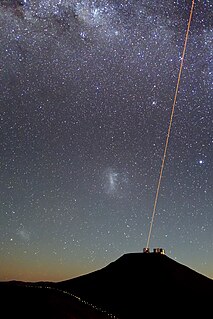
An optical amplifier is a device that amplifies an optical signal directly, without the need to first convert it to an electrical signal. An optical amplifier may be thought of as a laser without an optical cavity, or one in which feedback from the cavity is suppressed. Optical amplifiers are important in optical communication and laser physics. They are used as optical repeaters in the long distance fiberoptic cables which carry much of the world's telecommunication links.
Mode locking is a technique in optics by which a laser can be made to produce pulses of light of extremely short duration, on the order of picoseconds (10−12 s) or femtoseconds (10−15 s). A laser operated in this way is sometimes referred to as a femtosecond laser, for example, in modern refractive surgery. The basis of the technique is to induce a fixed phase relationship between the longitudinal modes of the laser's resonant cavity. Constructive interference between these modes can cause the laser light to be produced as a train of pulses. The laser is then said to be "phase-locked" or "mode-locked".
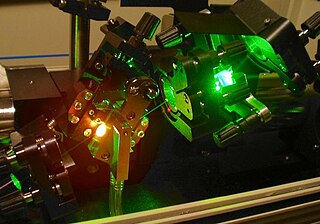
Ti:sapphire lasers (also known as Ti:Al2O3 lasers, titanium-sapphire lasers, or Ti:sapphs) are tunable lasers which emit red and near-infrared light in the range from 650 to 1100 nanometers. These lasers are mainly used in scientific research because of their tunability and their ability to generate ultrashort pulses. Lasers based on Ti:sapphire were first constructed and invented in June 1982 by Peter Moulton at the MIT Lincoln Laboratory.

Kerr-lens mode-locking (KLM) is a method of mode-locking lasers via the nonlinear optical Kerr effect. This method allows the generation of pulses of light with a duration as short as a few femtoseconds.
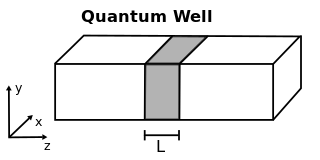
A quantum well is a potential well with only discrete energy values.

In physics, terahertz time-domain spectroscopy (THz-TDS) is a spectroscopic technique in which the properties of matter are probed with short pulses of terahertz radiation. The generation and detection scheme is sensitive to the sample's effect on both the amplitude and the phase of the terahertz radiation.
Saturable absorption is a property of materials where the absorption of light decreases with increasing light intensity. Most materials show some saturable absorption, but often only at very high optical intensities. At sufficiently high incident light intensity, the ground state of a saturable absorber material is excited into an upper energy state at such a rate that there is insufficient time for it to decay back to the ground state before the ground state becomes depleted, causing the absorption to saturate. The key parameters for a saturable absorber are its wavelength range, its dynamic response, and its saturation intensity and fluence.

A solid-state laser is a laser that uses a gain medium that is a solid, rather than a liquid as in dye lasers or a gas as in gas lasers. Semiconductor-based lasers are also in the solid state, but are generally considered as a separate class from solid-state lasers, called laser diodes.
A fiber laser is a laser in which the active gain medium is an optical fiber doped with rare-earth elements such as erbium, ytterbium, neodymium, dysprosium, praseodymium, thulium and holmium. They are related to doped fiber amplifiers, which provide light amplification without lasing. Fiber nonlinearities, such as stimulated Raman scattering or four-wave mixing can also provide gain and thus serve as gain media for a fiber laser.
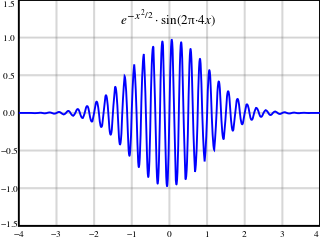
In optics, a frequency comb is a laser source whose spectrum consists of a series of discrete, equally spaced frequency lines. Frequency combs can be generated by a number of mechanisms, including periodic modulation of a continuous-wave laser, four-wave mixing in nonlinear media, or stabilization of the pulse train generated by a mode-locked laser. Much work has been devoted to this last mechanism, which was developed around the turn of the 21st century and ultimately led to one half of the Nobel Prize in Physics being shared by John L. Hall and Theodor W. Hänsch in 2005.
Silicon photonics is the study and application of photonic systems which use silicon as an optical medium. The silicon is usually patterned with sub-micrometre precision, into microphotonic components. These operate in the infrared, most commonly at the 1.55 micrometre wavelength used by most fiber optic telecommunication systems. The silicon typically lies on top of a layer of silica in what is known as silicon on insulator (SOI).

In optics, a supercontinuum is formed when a collection of nonlinear processes act together upon a pump beam in order to cause severe spectral broadening of the original pump beam, for example using a microstructured optical fiber. The result is a smooth spectral continuum. There is no consensus on how much broadening constitutes a supercontinuum; however researchers have published work claiming as little as 60 nm of broadening as a supercontinuum. There is also no agreement on the spectral flatness required to define the bandwidth of the source, with authors using anything from 5 dB to 40 dB or more. In addition the term supercontinuum itself did not gain widespread acceptance until this century, with many authors using alternative phrases to describe their continua during the 1970s, 1980s and 1990s.
Dissipative solitons (DSs) are stable solitary localized structures that arise in nonlinear spatially extended dissipative systems due to mechanisms of self-organization. They can be considered as an extension of the classical soliton concept in conservative systems. An alternative terminology includes autosolitons, spots and pulses.
In physics, a pulse is a generic term describing a single disturbance that moves through a transmission medium. This medium may be vacuum or matter, and may be indefinitely large or finite.
In physical optics or wave optics, a vector soliton is a solitary wave with multiple components coupled together that maintains its shape during propagation. Ordinary solitons maintain their shape but have effectively only one (scalar) polarization component, while vector solitons have two distinct polarization components. Among all the types of solitons, optical vector solitons draw the most attention due to their wide range of applications, particularly in generating ultrafast pulses and light control technology. Optical vector solitons can be classified into temporal vector solitons and spatial vector solitons. During the propagation of both temporal solitons and spatial solitons, despite being in a medium with birefringence, the orthogonal polarizations can copropagate as one unit without splitting due to the strong cross-phase modulation and coherent energy exchange between the two polarizations of the vector soliton which may induce intensity differences between these two polarizations. Thus vector solitons are no longer linearly polarized but rather elliptically polarized.

Fourier domain mode locking (FDML) is a laser modelocking technique that creates a continuous wave, wavelength-swept light output.
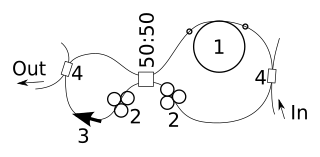
A figure-8 laser is a fiber laser with a figure-8-shaped ring resonator. It is used for making pico- and femtosecond soliton pulses. The typical spectrum of such a laser consists of a wide central peak and a few narrow lateral peaks that are placed symmetrically around it. The amplitudes of the narrow peaks are the same as or less than that of the central peak.
A domain wall is a term used in physics which can have similar meanings in optics, magnetism, or string theory. These phenomena can all be generically described as topological solitons which occur whenever a discrete symmetry is spontaneously broken.

Ursula Keller is a Swiss physicist. She has been a physics professor at the ETH Zurich, Switzerland since 2003 with a speciality in ultra-fast laser technology, an inventor and the winner of the 2018 European Inventor Award by the European Patent Office.
References
- ↑ "The Group". ulp.ethz.ch. Retrieved 2020-05-10.
- ↑ H. Zhang et al., "Induced solitons formed by cross polarization coupling in a birefringent cavity fiber laser" Archived 2011-07-07 at the Wayback Machine , Opt. Lett., 33, 2317–2319. (2008).
- ↑ D.Y. Tang et al., "Observation of high-order polarization-locked vector solitons in a fiber laser" Archived 2010-01-20 at the Wayback Machine , Physical Review Letters, 101, 153904 (2008).
- ↑ H. Zhang et al., "Coherent energy exchange between components of a vector soliton in fiber lasers", Optics Express, 16,12618–12623 (2008).
- ↑ Zhang H.; et al. (2009). "Multi-wavelength dissipative soliton operation of an erbium-doped fiber laser". Optics Express. 17 (2): 12692–12697. arXiv: 0907.1782 . Bibcode:2009OExpr..1712692Z. doi:10.1364/oe.17.012692. PMID 19654674. S2CID 1512526.
- ↑ L.M. Zhao et al., "Polarization rotation locking of vector solitons in a fiber ring laser" Archived 2011-07-07 at the Wayback Machine , Optics Express, 16,10053–10058 (2008).